Analysis of Mexican Cultural Competence in U.S. Health Care Systems
VerifiedAdded on 2022/11/28
|17
|4296
|405
Report
AI Summary
This report examines the significance of Mexican cultural competence within the U.S. healthcare system. It explores the impact of cultural understanding on healthcare delivery, focusing on health disparities and the challenges faced by Mexican immigrants. The report discusses the influence of socio-economic factors and health insurance coverage. Specific diseases like HIV, TB, Zika virus, Ebola, and Hepatitis are analyzed in the context of cultural competence, along with quarantine measures. The healthcare system in the United States is also evaluated, highlighting its unique aspects and the need for culturally sensitive practices. The report emphasizes the importance of health care providers being culturally competent to improve patient outcomes and address the diverse needs of the Mexican population and other minority groups.
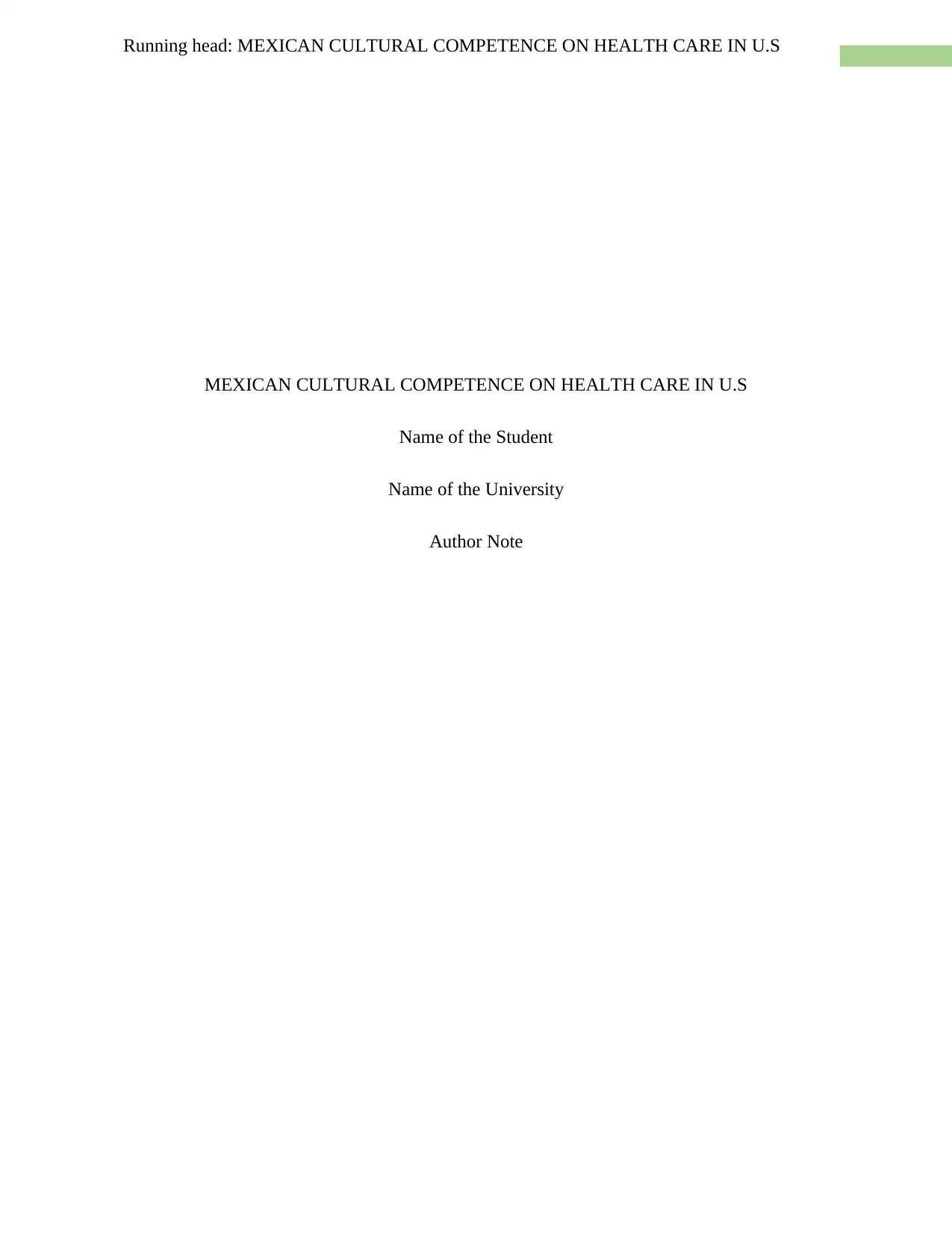
Running head: MEXICAN CULTURAL COMPETENCE ON HEALTH CARE IN U.S
MEXICAN CULTURAL COMPETENCE ON HEALTH CARE IN U.S
Name of the Student
Name of the University
Author Note
MEXICAN CULTURAL COMPETENCE ON HEALTH CARE IN U.S
Name of the Student
Name of the University
Author Note
Paraphrase This Document
Need a fresh take? Get an instant paraphrase of this document with our AI Paraphraser
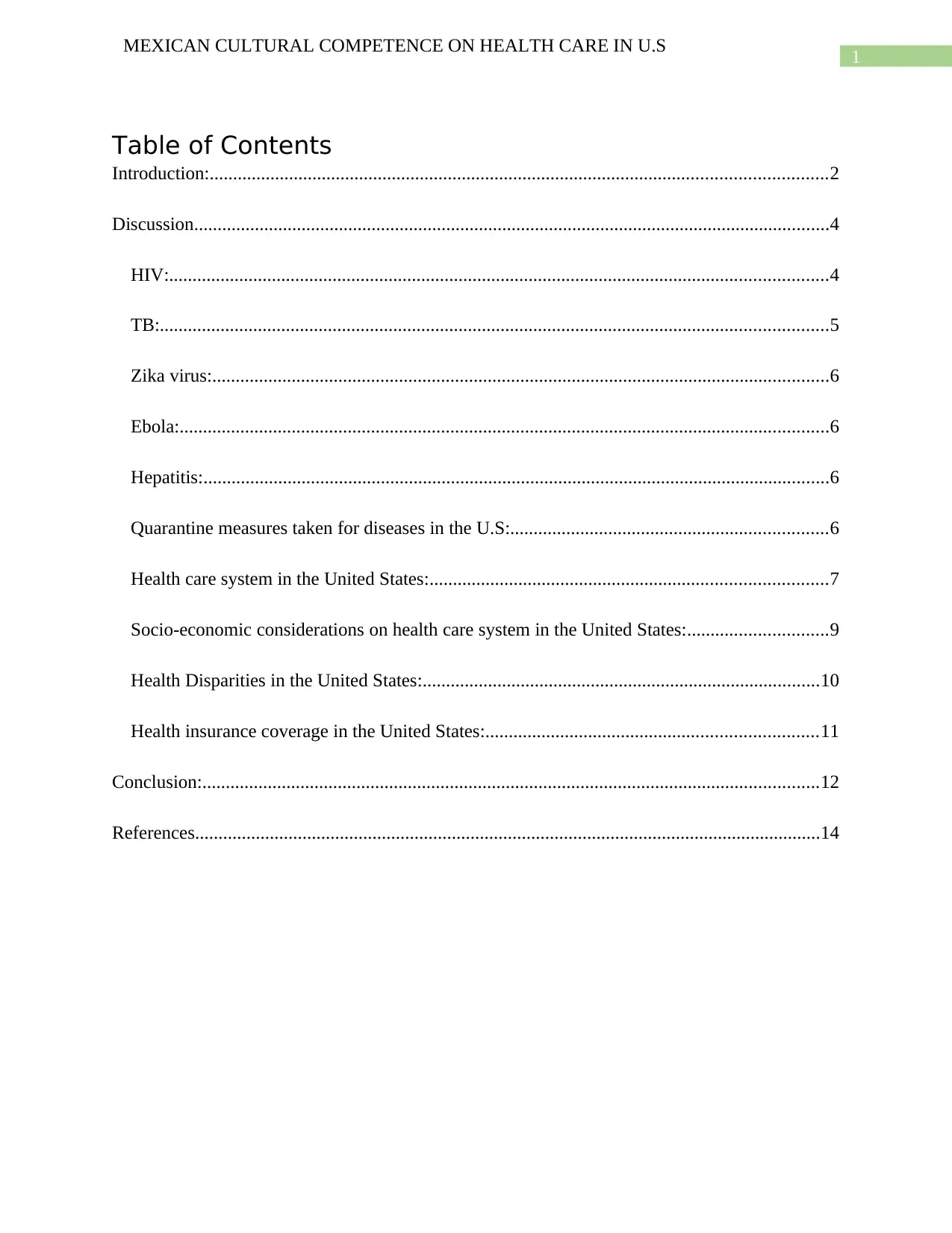
1
MEXICAN CULTURAL COMPETENCE ON HEALTH CARE IN U.S
Table of Contents
Introduction:....................................................................................................................................2
Discussion........................................................................................................................................4
HIV:.............................................................................................................................................4
TB:...............................................................................................................................................5
Zika virus:....................................................................................................................................6
Ebola:...........................................................................................................................................6
Hepatitis:......................................................................................................................................6
Quarantine measures taken for diseases in the U.S:....................................................................6
Health care system in the United States:.....................................................................................7
Socio-economic considerations on health care system in the United States:..............................9
Health Disparities in the United States:.....................................................................................10
Health insurance coverage in the United States:.......................................................................11
Conclusion:....................................................................................................................................12
References......................................................................................................................................14
MEXICAN CULTURAL COMPETENCE ON HEALTH CARE IN U.S
Table of Contents
Introduction:....................................................................................................................................2
Discussion........................................................................................................................................4
HIV:.............................................................................................................................................4
TB:...............................................................................................................................................5
Zika virus:....................................................................................................................................6
Ebola:...........................................................................................................................................6
Hepatitis:......................................................................................................................................6
Quarantine measures taken for diseases in the U.S:....................................................................6
Health care system in the United States:.....................................................................................7
Socio-economic considerations on health care system in the United States:..............................9
Health Disparities in the United States:.....................................................................................10
Health insurance coverage in the United States:.......................................................................11
Conclusion:....................................................................................................................................12
References......................................................................................................................................14
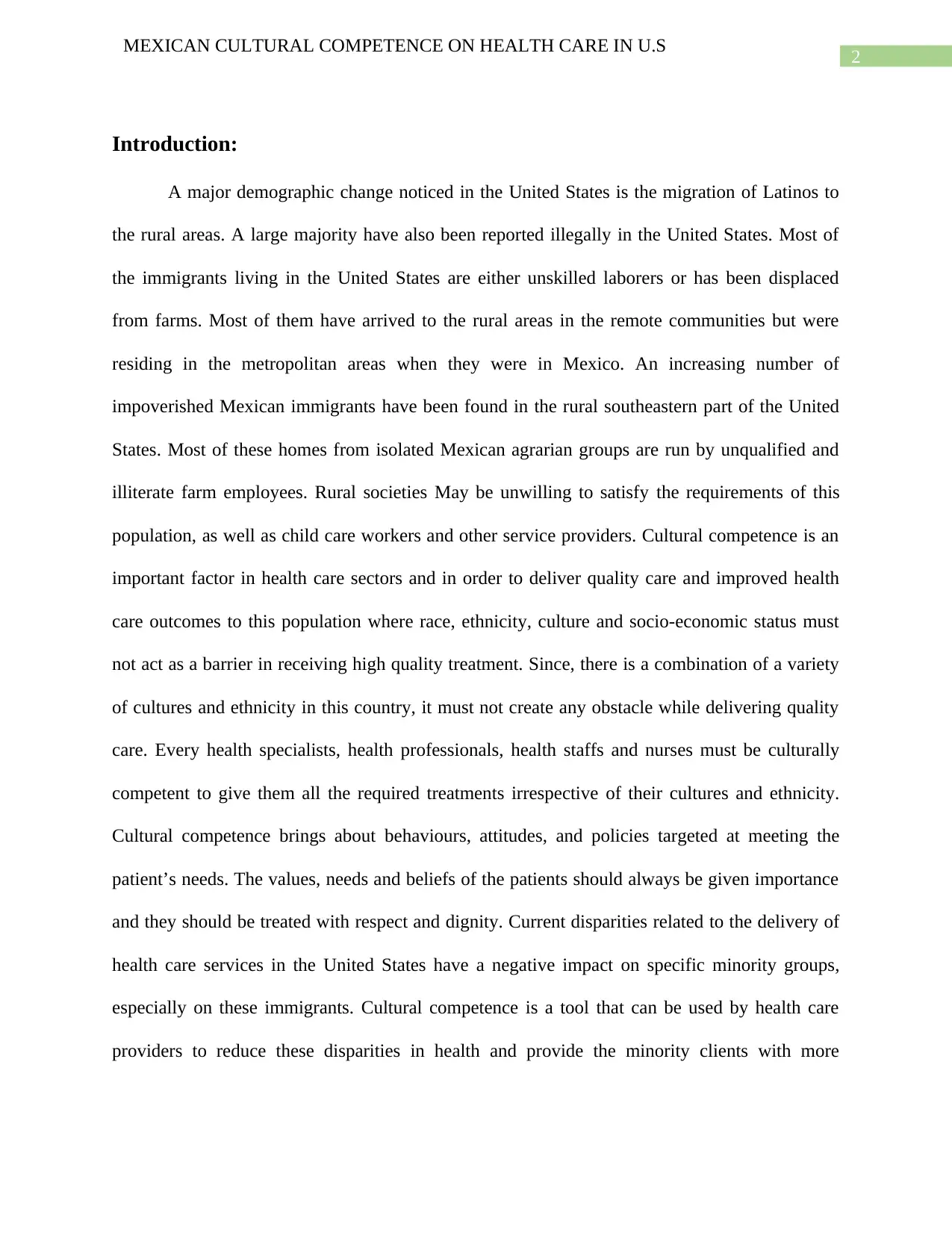
2
MEXICAN CULTURAL COMPETENCE ON HEALTH CARE IN U.S
Introduction:
A major demographic change noticed in the United States is the migration of Latinos to
the rural areas. A large majority have also been reported illegally in the United States. Most of
the immigrants living in the United States are either unskilled laborers or has been displaced
from farms. Most of them have arrived to the rural areas in the remote communities but were
residing in the metropolitan areas when they were in Mexico. An increasing number of
impoverished Mexican immigrants have been found in the rural southeastern part of the United
States. Most of these homes from isolated Mexican agrarian groups are run by unqualified and
illiterate farm employees. Rural societies May be unwilling to satisfy the requirements of this
population, as well as child care workers and other service providers. Cultural competence is an
important factor in health care sectors and in order to deliver quality care and improved health
care outcomes to this population where race, ethnicity, culture and socio-economic status must
not act as a barrier in receiving high quality treatment. Since, there is a combination of a variety
of cultures and ethnicity in this country, it must not create any obstacle while delivering quality
care. Every health specialists, health professionals, health staffs and nurses must be culturally
competent to give them all the required treatments irrespective of their cultures and ethnicity.
Cultural competence brings about behaviours, attitudes, and policies targeted at meeting the
patient’s needs. The values, needs and beliefs of the patients should always be given importance
and they should be treated with respect and dignity. Current disparities related to the delivery of
health care services in the United States have a negative impact on specific minority groups,
especially on these immigrants. Cultural competence is a tool that can be used by health care
providers to reduce these disparities in health and provide the minority clients with more
MEXICAN CULTURAL COMPETENCE ON HEALTH CARE IN U.S
Introduction:
A major demographic change noticed in the United States is the migration of Latinos to
the rural areas. A large majority have also been reported illegally in the United States. Most of
the immigrants living in the United States are either unskilled laborers or has been displaced
from farms. Most of them have arrived to the rural areas in the remote communities but were
residing in the metropolitan areas when they were in Mexico. An increasing number of
impoverished Mexican immigrants have been found in the rural southeastern part of the United
States. Most of these homes from isolated Mexican agrarian groups are run by unqualified and
illiterate farm employees. Rural societies May be unwilling to satisfy the requirements of this
population, as well as child care workers and other service providers. Cultural competence is an
important factor in health care sectors and in order to deliver quality care and improved health
care outcomes to this population where race, ethnicity, culture and socio-economic status must
not act as a barrier in receiving high quality treatment. Since, there is a combination of a variety
of cultures and ethnicity in this country, it must not create any obstacle while delivering quality
care. Every health specialists, health professionals, health staffs and nurses must be culturally
competent to give them all the required treatments irrespective of their cultures and ethnicity.
Cultural competence brings about behaviours, attitudes, and policies targeted at meeting the
patient’s needs. The values, needs and beliefs of the patients should always be given importance
and they should be treated with respect and dignity. Current disparities related to the delivery of
health care services in the United States have a negative impact on specific minority groups,
especially on these immigrants. Cultural competence is a tool that can be used by health care
providers to reduce these disparities in health and provide the minority clients with more
⊘ This is a preview!⊘
Do you want full access?
Subscribe today to unlock all pages.

Trusted by 1+ million students worldwide

3
MEXICAN CULTURAL COMPETENCE ON HEALTH CARE IN U.S
effective and quality care. The paper throws light on the Mexican cultural competence in the
United States health care system with health insurance strategies followed in the United States.
MEXICAN CULTURAL COMPETENCE ON HEALTH CARE IN U.S
effective and quality care. The paper throws light on the Mexican cultural competence in the
United States health care system with health insurance strategies followed in the United States.
Paraphrase This Document
Need a fresh take? Get an instant paraphrase of this document with our AI Paraphraser
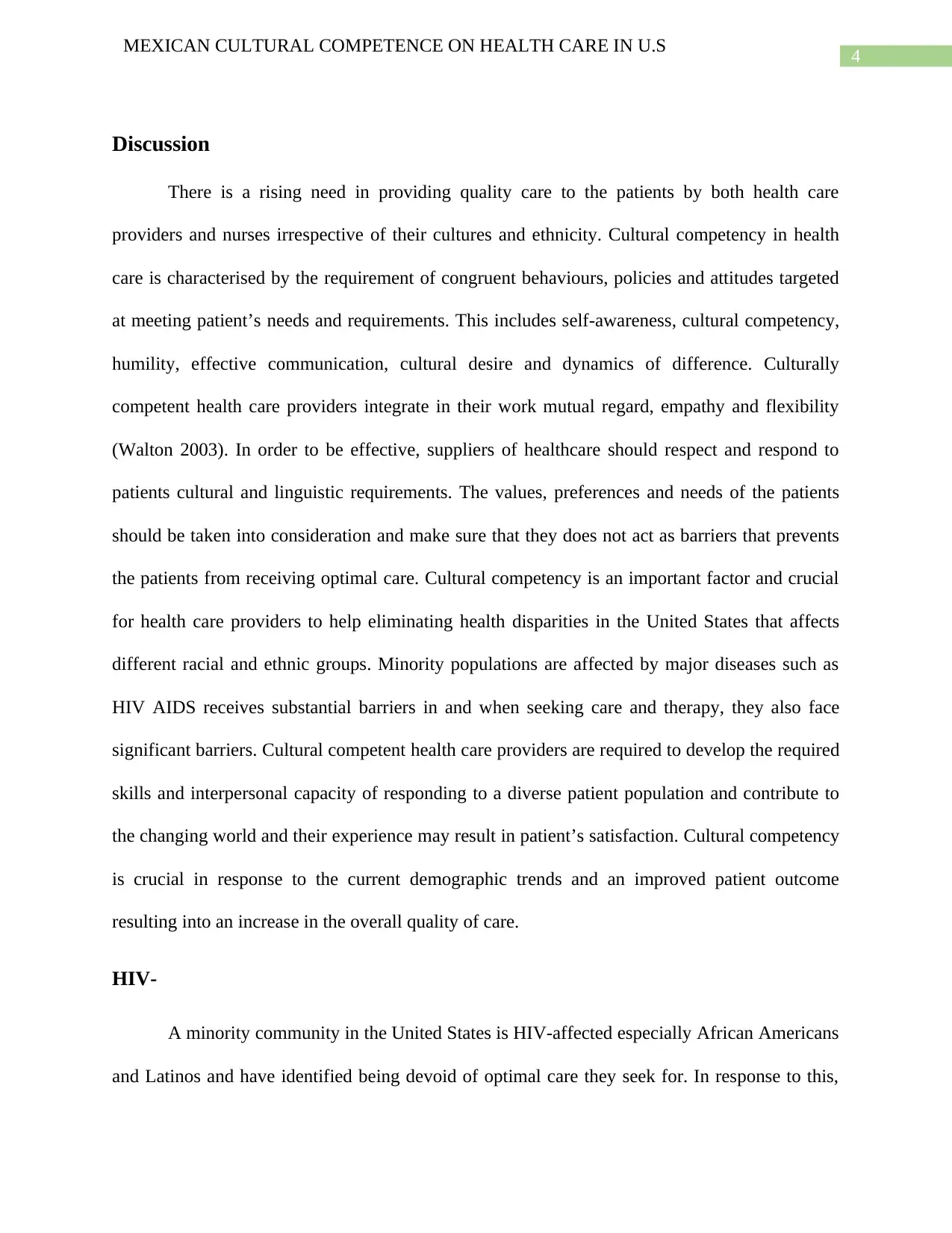
4
MEXICAN CULTURAL COMPETENCE ON HEALTH CARE IN U.S
Discussion
There is a rising need in providing quality care to the patients by both health care
providers and nurses irrespective of their cultures and ethnicity. Cultural competency in health
care is characterised by the requirement of congruent behaviours, policies and attitudes targeted
at meeting patient’s needs and requirements. This includes self-awareness, cultural competency,
humility, effective communication, cultural desire and dynamics of difference. Culturally
competent health care providers integrate in their work mutual regard, empathy and flexibility
(Walton 2003). In order to be effective, suppliers of healthcare should respect and respond to
patients cultural and linguistic requirements. The values, preferences and needs of the patients
should be taken into consideration and make sure that they does not act as barriers that prevents
the patients from receiving optimal care. Cultural competency is an important factor and crucial
for health care providers to help eliminating health disparities in the United States that affects
different racial and ethnic groups. Minority populations are affected by major diseases such as
HIV AIDS receives substantial barriers in and when seeking care and therapy, they also face
significant barriers. Cultural competent health care providers are required to develop the required
skills and interpersonal capacity of responding to a diverse patient population and contribute to
the changing world and their experience may result in patient’s satisfaction. Cultural competency
is crucial in response to the current demographic trends and an improved patient outcome
resulting into an increase in the overall quality of care.
HIV-
A minority community in the United States is HIV-affected especially African Americans
and Latinos and have identified being devoid of optimal care they seek for. In response to this,
MEXICAN CULTURAL COMPETENCE ON HEALTH CARE IN U.S
Discussion
There is a rising need in providing quality care to the patients by both health care
providers and nurses irrespective of their cultures and ethnicity. Cultural competency in health
care is characterised by the requirement of congruent behaviours, policies and attitudes targeted
at meeting patient’s needs and requirements. This includes self-awareness, cultural competency,
humility, effective communication, cultural desire and dynamics of difference. Culturally
competent health care providers integrate in their work mutual regard, empathy and flexibility
(Walton 2003). In order to be effective, suppliers of healthcare should respect and respond to
patients cultural and linguistic requirements. The values, preferences and needs of the patients
should be taken into consideration and make sure that they does not act as barriers that prevents
the patients from receiving optimal care. Cultural competency is an important factor and crucial
for health care providers to help eliminating health disparities in the United States that affects
different racial and ethnic groups. Minority populations are affected by major diseases such as
HIV AIDS receives substantial barriers in and when seeking care and therapy, they also face
significant barriers. Cultural competent health care providers are required to develop the required
skills and interpersonal capacity of responding to a diverse patient population and contribute to
the changing world and their experience may result in patient’s satisfaction. Cultural competency
is crucial in response to the current demographic trends and an improved patient outcome
resulting into an increase in the overall quality of care.
HIV-
A minority community in the United States is HIV-affected especially African Americans
and Latinos and have identified being devoid of optimal care they seek for. In response to this,

5
MEXICAN CULTURAL COMPETENCE ON HEALTH CARE IN U.S
The National Minority AIDS Education and Training Centre (NMAETC) in collaboration of
health professionals financed by the University of Texas Health Science Centre's Health
Resources and Service Administrators at San Antonio and the National Council of La Raza,
focuses on strengthening infrastructures and improving the quality of services to HIC patients by
using collaborative approaches and delivering best care practices. They have developed a
cultural competency model used by health care providers treating Latino patients with human
immunodeficiency virus (HIV) and acquired immunodeficiency syndrome (AIDS). The model
proposed by them, BE SAFE, has the six major elements such as Barriers to care, ethics, supplier
sensitivity, evaluation, facts and encounters. These components provide a cultural framework
that assists the health care providers in serving quality care to the patients.
TB-
Tuberculosis is a deadly disease affecting people worldwide irrespective of their socio
economic status. However, poor and marginalized group of society are more prone to this disease
both worldwide as well as around the world. The high occurrence of TB among the Foreign-born
people in the United States present challenges to national public health programs across the
country which is caused by the various factors. People born outside the United States faces
frequently experience difficulties associated with private or cultural convictions, behaviours and
requirements when accessing TB facilities. Cultural competence in health care aims at providing
an improved quality care to the patients and it is a key element in the field of health care that
provides an improved health outcome that eventually leads to an increased patient’s satisfaction.
A number of behaviours, attitudes, abilities and policies are built on cultural competence that
enables the health organizations work effectively and treat every individual with care irrespective
of their culture and ethnicity.
MEXICAN CULTURAL COMPETENCE ON HEALTH CARE IN U.S
The National Minority AIDS Education and Training Centre (NMAETC) in collaboration of
health professionals financed by the University of Texas Health Science Centre's Health
Resources and Service Administrators at San Antonio and the National Council of La Raza,
focuses on strengthening infrastructures and improving the quality of services to HIC patients by
using collaborative approaches and delivering best care practices. They have developed a
cultural competency model used by health care providers treating Latino patients with human
immunodeficiency virus (HIV) and acquired immunodeficiency syndrome (AIDS). The model
proposed by them, BE SAFE, has the six major elements such as Barriers to care, ethics, supplier
sensitivity, evaluation, facts and encounters. These components provide a cultural framework
that assists the health care providers in serving quality care to the patients.
TB-
Tuberculosis is a deadly disease affecting people worldwide irrespective of their socio
economic status. However, poor and marginalized group of society are more prone to this disease
both worldwide as well as around the world. The high occurrence of TB among the Foreign-born
people in the United States present challenges to national public health programs across the
country which is caused by the various factors. People born outside the United States faces
frequently experience difficulties associated with private or cultural convictions, behaviours and
requirements when accessing TB facilities. Cultural competence in health care aims at providing
an improved quality care to the patients and it is a key element in the field of health care that
provides an improved health outcome that eventually leads to an increased patient’s satisfaction.
A number of behaviours, attitudes, abilities and policies are built on cultural competence that
enables the health organizations work effectively and treat every individual with care irrespective
of their culture and ethnicity.
⊘ This is a preview!⊘
Do you want full access?
Subscribe today to unlock all pages.

Trusted by 1+ million students worldwide
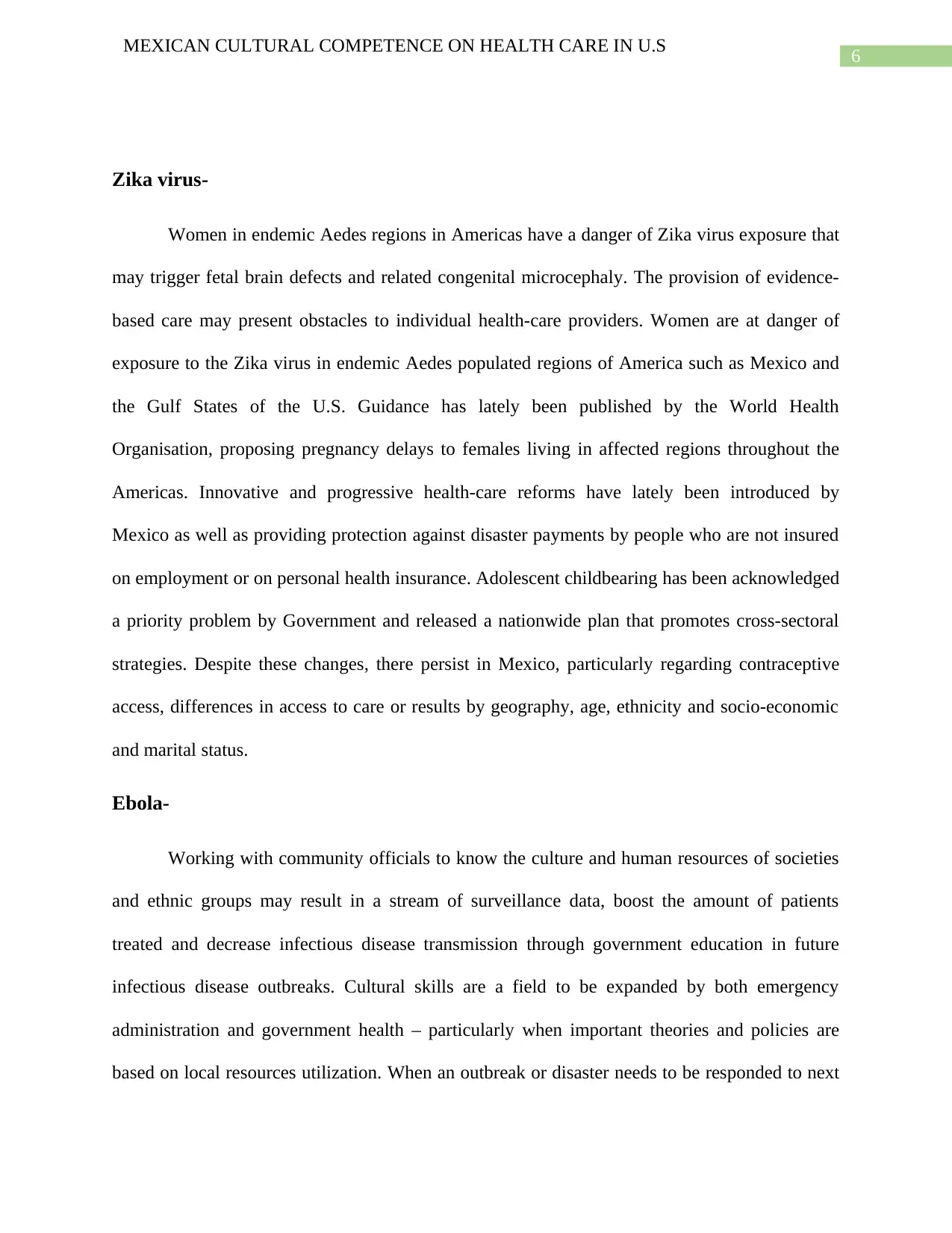
6
MEXICAN CULTURAL COMPETENCE ON HEALTH CARE IN U.S
Zika virus-
Women in endemic Aedes regions in Americas have a danger of Zika virus exposure that
may trigger fetal brain defects and related congenital microcephaly. The provision of evidence-
based care may present obstacles to individual health-care providers. Women are at danger of
exposure to the Zika virus in endemic Aedes populated regions of America such as Mexico and
the Gulf States of the U.S. Guidance has lately been published by the World Health
Organisation, proposing pregnancy delays to females living in affected regions throughout the
Americas. Innovative and progressive health-care reforms have lately been introduced by
Mexico as well as providing protection against disaster payments by people who are not insured
on employment or on personal health insurance. Adolescent childbearing has been acknowledged
a priority problem by Government and released a nationwide plan that promotes cross-sectoral
strategies. Despite these changes, there persist in Mexico, particularly regarding contraceptive
access, differences in access to care or results by geography, age, ethnicity and socio-economic
and marital status.
Ebola-
Working with community officials to know the culture and human resources of societies
and ethnic groups may result in a stream of surveillance data, boost the amount of patients
treated and decrease infectious disease transmission through government education in future
infectious disease outbreaks. Cultural skills are a field to be expanded by both emergency
administration and government health – particularly when important theories and policies are
based on local resources utilization. When an outbreak or disaster needs to be responded to next
MEXICAN CULTURAL COMPETENCE ON HEALTH CARE IN U.S
Zika virus-
Women in endemic Aedes regions in Americas have a danger of Zika virus exposure that
may trigger fetal brain defects and related congenital microcephaly. The provision of evidence-
based care may present obstacles to individual health-care providers. Women are at danger of
exposure to the Zika virus in endemic Aedes populated regions of America such as Mexico and
the Gulf States of the U.S. Guidance has lately been published by the World Health
Organisation, proposing pregnancy delays to females living in affected regions throughout the
Americas. Innovative and progressive health-care reforms have lately been introduced by
Mexico as well as providing protection against disaster payments by people who are not insured
on employment or on personal health insurance. Adolescent childbearing has been acknowledged
a priority problem by Government and released a nationwide plan that promotes cross-sectoral
strategies. Despite these changes, there persist in Mexico, particularly regarding contraceptive
access, differences in access to care or results by geography, age, ethnicity and socio-economic
and marital status.
Ebola-
Working with community officials to know the culture and human resources of societies
and ethnic groups may result in a stream of surveillance data, boost the amount of patients
treated and decrease infectious disease transmission through government education in future
infectious disease outbreaks. Cultural skills are a field to be expanded by both emergency
administration and government health – particularly when important theories and policies are
based on local resources utilization. When an outbreak or disaster needs to be responded to next
Paraphrase This Document
Need a fresh take? Get an instant paraphrase of this document with our AI Paraphraser
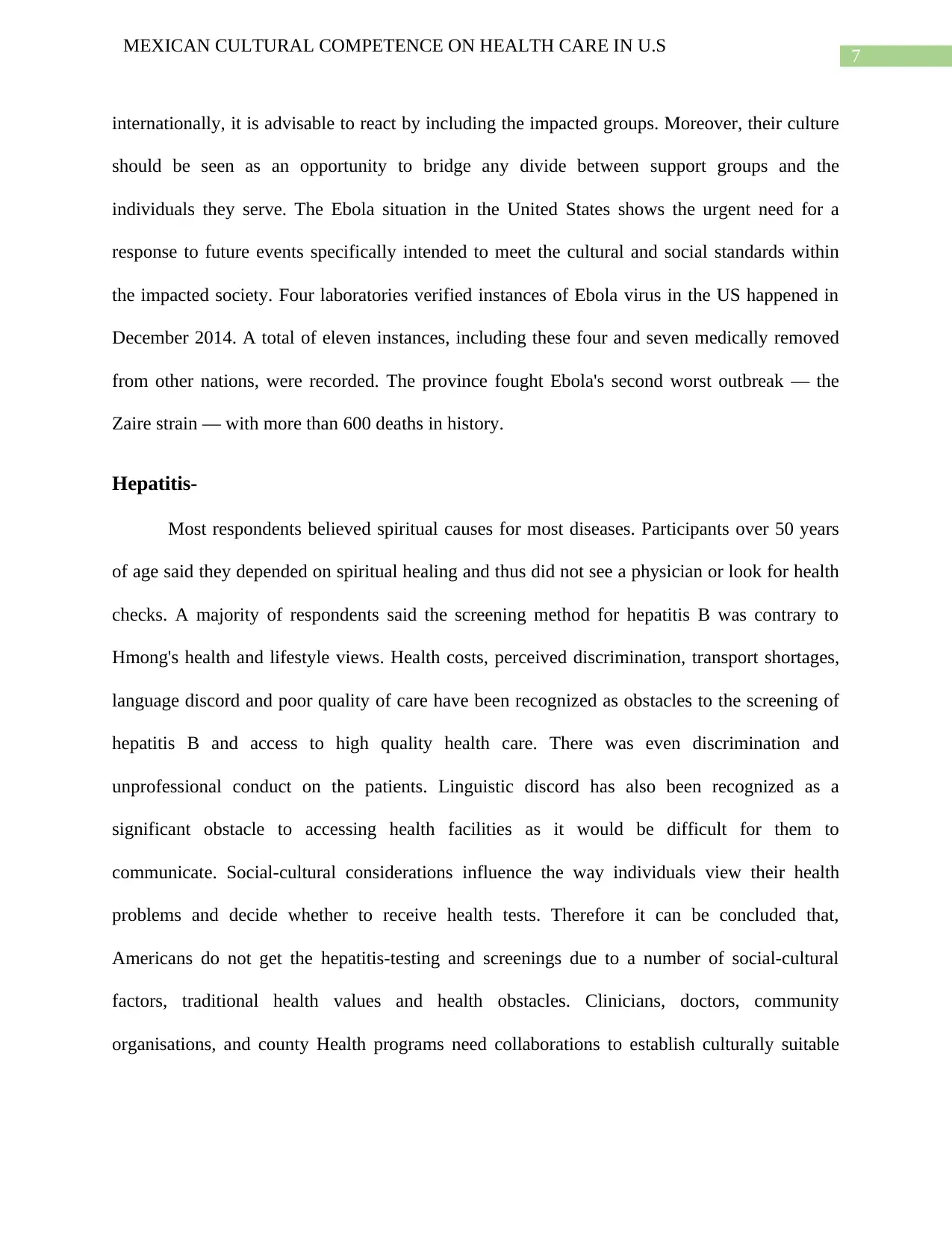
7
MEXICAN CULTURAL COMPETENCE ON HEALTH CARE IN U.S
internationally, it is advisable to react by including the impacted groups. Moreover, their culture
should be seen as an opportunity to bridge any divide between support groups and the
individuals they serve. The Ebola situation in the United States shows the urgent need for a
response to future events specifically intended to meet the cultural and social standards within
the impacted society. Four laboratories verified instances of Ebola virus in the US happened in
December 2014. A total of eleven instances, including these four and seven medically removed
from other nations, were recorded. The province fought Ebola's second worst outbreak — the
Zaire strain — with more than 600 deaths in history.
Hepatitis-
Most respondents believed spiritual causes for most diseases. Participants over 50 years
of age said they depended on spiritual healing and thus did not see a physician or look for health
checks. A majority of respondents said the screening method for hepatitis B was contrary to
Hmong's health and lifestyle views. Health costs, perceived discrimination, transport shortages,
language discord and poor quality of care have been recognized as obstacles to the screening of
hepatitis B and access to high quality health care. There was even discrimination and
unprofessional conduct on the patients. Linguistic discord has also been recognized as a
significant obstacle to accessing health facilities as it would be difficult for them to
communicate. Social-cultural considerations influence the way individuals view their health
problems and decide whether to receive health tests. Therefore it can be concluded that,
Americans do not get the hepatitis-testing and screenings due to a number of social-cultural
factors, traditional health values and health obstacles. Clinicians, doctors, community
organisations, and county Health programs need collaborations to establish culturally suitable
MEXICAN CULTURAL COMPETENCE ON HEALTH CARE IN U.S
internationally, it is advisable to react by including the impacted groups. Moreover, their culture
should be seen as an opportunity to bridge any divide between support groups and the
individuals they serve. The Ebola situation in the United States shows the urgent need for a
response to future events specifically intended to meet the cultural and social standards within
the impacted society. Four laboratories verified instances of Ebola virus in the US happened in
December 2014. A total of eleven instances, including these four and seven medically removed
from other nations, were recorded. The province fought Ebola's second worst outbreak — the
Zaire strain — with more than 600 deaths in history.
Hepatitis-
Most respondents believed spiritual causes for most diseases. Participants over 50 years
of age said they depended on spiritual healing and thus did not see a physician or look for health
checks. A majority of respondents said the screening method for hepatitis B was contrary to
Hmong's health and lifestyle views. Health costs, perceived discrimination, transport shortages,
language discord and poor quality of care have been recognized as obstacles to the screening of
hepatitis B and access to high quality health care. There was even discrimination and
unprofessional conduct on the patients. Linguistic discord has also been recognized as a
significant obstacle to accessing health facilities as it would be difficult for them to
communicate. Social-cultural considerations influence the way individuals view their health
problems and decide whether to receive health tests. Therefore it can be concluded that,
Americans do not get the hepatitis-testing and screenings due to a number of social-cultural
factors, traditional health values and health obstacles. Clinicians, doctors, community
organisations, and county Health programs need collaborations to establish culturally suitable
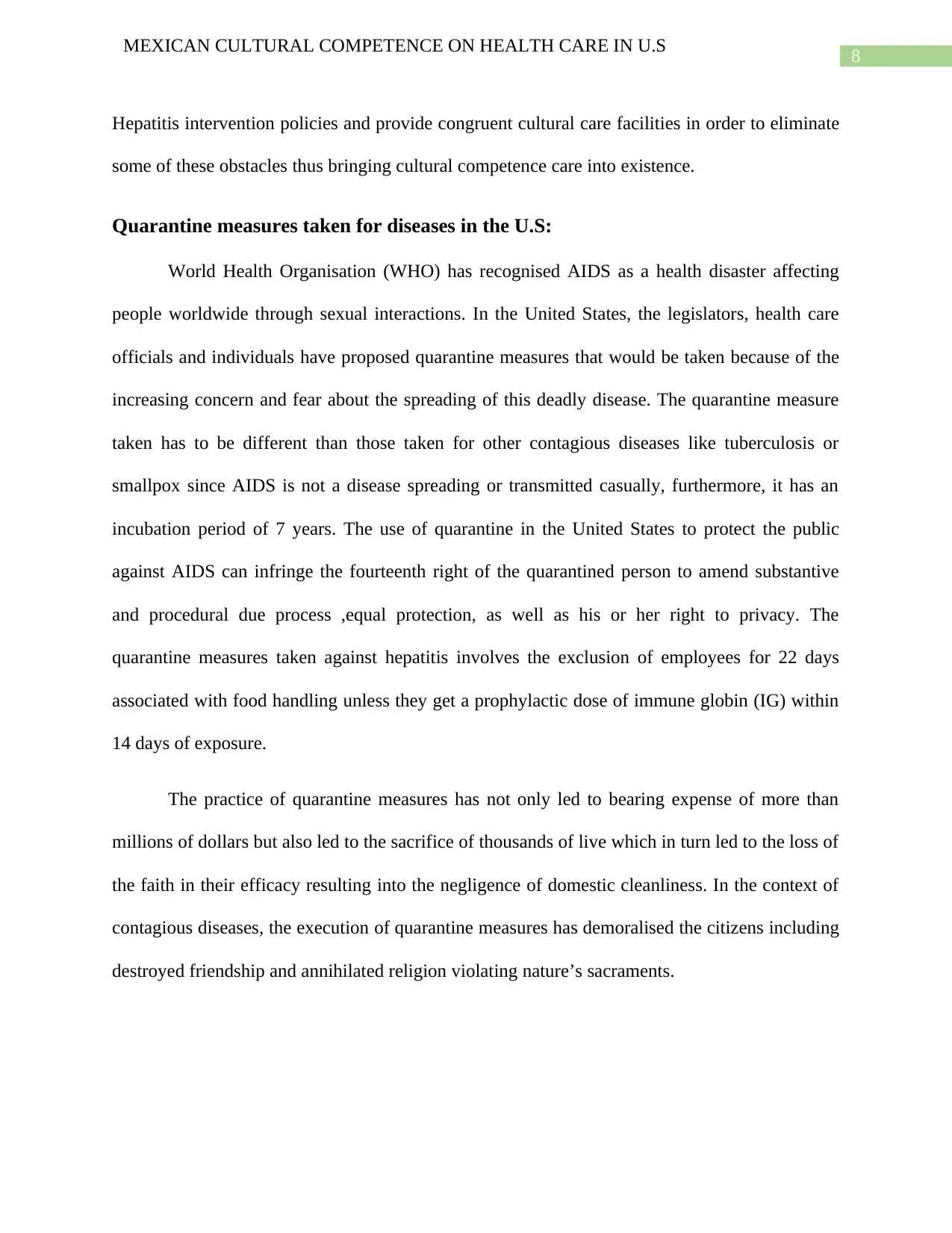
8
MEXICAN CULTURAL COMPETENCE ON HEALTH CARE IN U.S
Hepatitis intervention policies and provide congruent cultural care facilities in order to eliminate
some of these obstacles thus bringing cultural competence care into existence.
Quarantine measures taken for diseases in the U.S:
World Health Organisation (WHO) has recognised AIDS as a health disaster affecting
people worldwide through sexual interactions. In the United States, the legislators, health care
officials and individuals have proposed quarantine measures that would be taken because of the
increasing concern and fear about the spreading of this deadly disease. The quarantine measure
taken has to be different than those taken for other contagious diseases like tuberculosis or
smallpox since AIDS is not a disease spreading or transmitted casually, furthermore, it has an
incubation period of 7 years. The use of quarantine in the United States to protect the public
against AIDS can infringe the fourteenth right of the quarantined person to amend substantive
and procedural due process ,equal protection, as well as his or her right to privacy. The
quarantine measures taken against hepatitis involves the exclusion of employees for 22 days
associated with food handling unless they get a prophylactic dose of immune globin (IG) within
14 days of exposure.
The practice of quarantine measures has not only led to bearing expense of more than
millions of dollars but also led to the sacrifice of thousands of live which in turn led to the loss of
the faith in their efficacy resulting into the negligence of domestic cleanliness. In the context of
contagious diseases, the execution of quarantine measures has demoralised the citizens including
destroyed friendship and annihilated religion violating nature’s sacraments.
MEXICAN CULTURAL COMPETENCE ON HEALTH CARE IN U.S
Hepatitis intervention policies and provide congruent cultural care facilities in order to eliminate
some of these obstacles thus bringing cultural competence care into existence.
Quarantine measures taken for diseases in the U.S:
World Health Organisation (WHO) has recognised AIDS as a health disaster affecting
people worldwide through sexual interactions. In the United States, the legislators, health care
officials and individuals have proposed quarantine measures that would be taken because of the
increasing concern and fear about the spreading of this deadly disease. The quarantine measure
taken has to be different than those taken for other contagious diseases like tuberculosis or
smallpox since AIDS is not a disease spreading or transmitted casually, furthermore, it has an
incubation period of 7 years. The use of quarantine in the United States to protect the public
against AIDS can infringe the fourteenth right of the quarantined person to amend substantive
and procedural due process ,equal protection, as well as his or her right to privacy. The
quarantine measures taken against hepatitis involves the exclusion of employees for 22 days
associated with food handling unless they get a prophylactic dose of immune globin (IG) within
14 days of exposure.
The practice of quarantine measures has not only led to bearing expense of more than
millions of dollars but also led to the sacrifice of thousands of live which in turn led to the loss of
the faith in their efficacy resulting into the negligence of domestic cleanliness. In the context of
contagious diseases, the execution of quarantine measures has demoralised the citizens including
destroyed friendship and annihilated religion violating nature’s sacraments.
⊘ This is a preview!⊘
Do you want full access?
Subscribe today to unlock all pages.

Trusted by 1+ million students worldwide
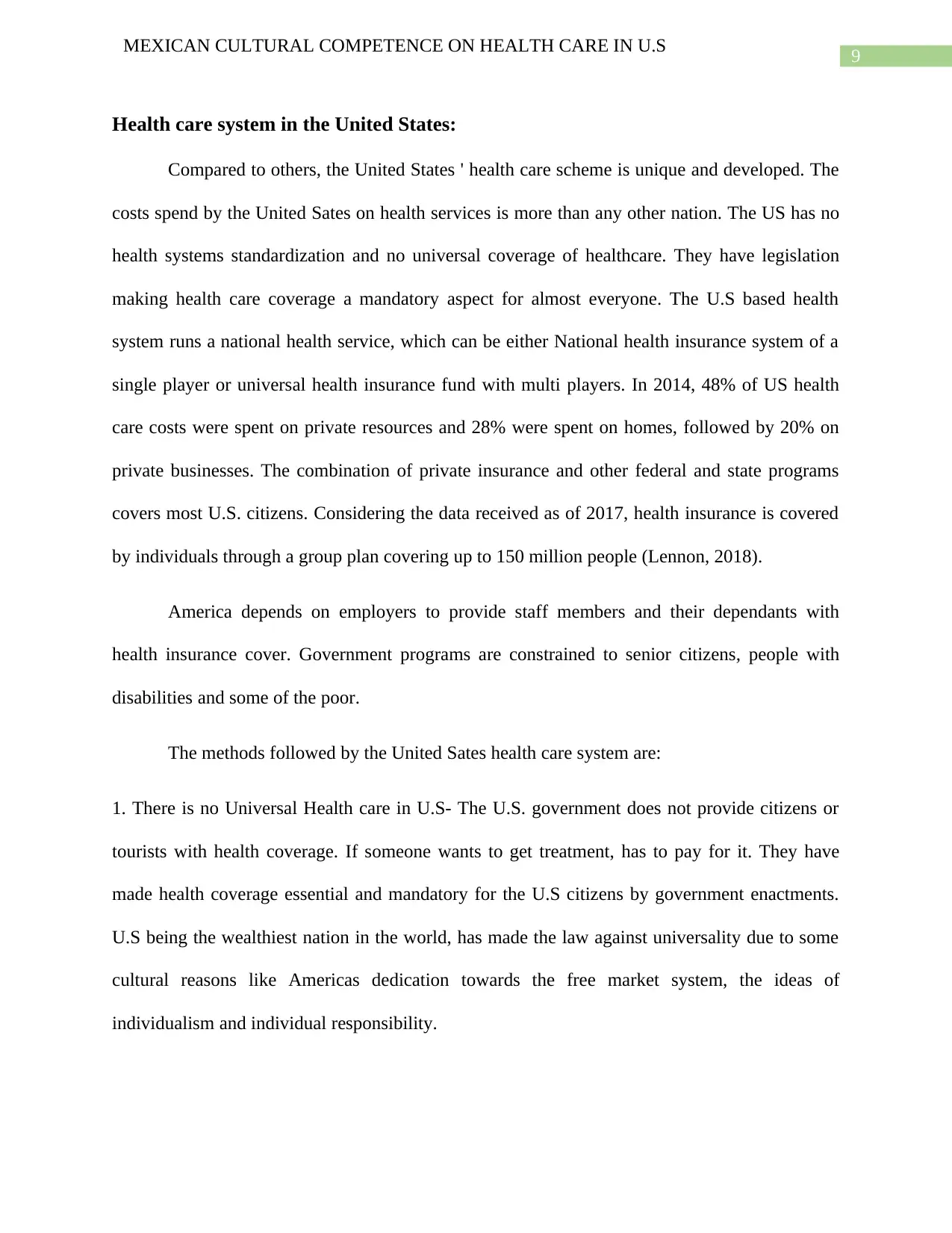
9
MEXICAN CULTURAL COMPETENCE ON HEALTH CARE IN U.S
Health care system in the United States:
Compared to others, the United States ' health care scheme is unique and developed. The
costs spend by the United Sates on health services is more than any other nation. The US has no
health systems standardization and no universal coverage of healthcare. They have legislation
making health care coverage a mandatory aspect for almost everyone. The U.S based health
system runs a national health service, which can be either National health insurance system of a
single player or universal health insurance fund with multi players. In 2014, 48% of US health
care costs were spent on private resources and 28% were spent on homes, followed by 20% on
private businesses. The combination of private insurance and other federal and state programs
covers most U.S. citizens. Considering the data received as of 2017, health insurance is covered
by individuals through a group plan covering up to 150 million people (Lennon, 2018).
America depends on employers to provide staff members and their dependants with
health insurance cover. Government programs are constrained to senior citizens, people with
disabilities and some of the poor.
The methods followed by the United Sates health care system are:
1. There is no Universal Health care in U.S- The U.S. government does not provide citizens or
tourists with health coverage. If someone wants to get treatment, has to pay for it. They have
made health coverage essential and mandatory for the U.S citizens by government enactments.
U.S being the wealthiest nation in the world, has made the law against universality due to some
cultural reasons like Americas dedication towards the free market system, the ideas of
individualism and individual responsibility.
MEXICAN CULTURAL COMPETENCE ON HEALTH CARE IN U.S
Health care system in the United States:
Compared to others, the United States ' health care scheme is unique and developed. The
costs spend by the United Sates on health services is more than any other nation. The US has no
health systems standardization and no universal coverage of healthcare. They have legislation
making health care coverage a mandatory aspect for almost everyone. The U.S based health
system runs a national health service, which can be either National health insurance system of a
single player or universal health insurance fund with multi players. In 2014, 48% of US health
care costs were spent on private resources and 28% were spent on homes, followed by 20% on
private businesses. The combination of private insurance and other federal and state programs
covers most U.S. citizens. Considering the data received as of 2017, health insurance is covered
by individuals through a group plan covering up to 150 million people (Lennon, 2018).
America depends on employers to provide staff members and their dependants with
health insurance cover. Government programs are constrained to senior citizens, people with
disabilities and some of the poor.
The methods followed by the United Sates health care system are:
1. There is no Universal Health care in U.S- The U.S. government does not provide citizens or
tourists with health coverage. If someone wants to get treatment, has to pay for it. They have
made health coverage essential and mandatory for the U.S citizens by government enactments.
U.S being the wealthiest nation in the world, has made the law against universality due to some
cultural reasons like Americas dedication towards the free market system, the ideas of
individualism and individual responsibility.
Paraphrase This Document
Need a fresh take? Get an instant paraphrase of this document with our AI Paraphraser

10
MEXICAN CULTURAL COMPETENCE ON HEALTH CARE IN U.S
2. The United States have a very expensive health care system: This is because health coverage
provides coverage in terms of money in case people with health coverage are exposed to any
diseases or health alterations. The expenses of such circumstances, sometimes incurred in
profound debt, or even bankruptcy, can be prevented through medical insurance.
The following medical costs can be avoided through health coverage:
It can cost up to $7,500 to fix the broken legs.
A 3-day hospital stay is approximately $30,000 on average.
Hundreds of thousands of dollars for comprehensive cancer treatment.
Health coverage can assist safeguard against elevated, unanticipated expenses such as
these. ("Health coverage protects you from high medical costs", 2019).
3. Most of the care will be from the “Primary care provider” (PCP): In the US one has to pick up
a PCP that is also a part of the insurance company after purchasing medical insurance. The PCP
can either be nurse or a practitioner or physician. PCPs are called generalists since they are
treated as personal clinicians and responsible for handling most of the healthcare needs. They
have the ability to diagnosis illnesses, recommend and order laboratory tests, develop treatment
plans and also write prescriptions.
Socio-economic considerations on health care system in the United States:
There are evidences showing the outcome and health care received by the individuals are
affected by their social economic status. People with a poor social economy position are more
likely to experience the worst health conditions, lower life expectancy and are suffered from
many chronic diseases. Due to their rising expenses and coverage, their access to health facilities
is restricted. They are even less likely to be perceived by the physicians and other health care
MEXICAN CULTURAL COMPETENCE ON HEALTH CARE IN U.S
2. The United States have a very expensive health care system: This is because health coverage
provides coverage in terms of money in case people with health coverage are exposed to any
diseases or health alterations. The expenses of such circumstances, sometimes incurred in
profound debt, or even bankruptcy, can be prevented through medical insurance.
The following medical costs can be avoided through health coverage:
It can cost up to $7,500 to fix the broken legs.
A 3-day hospital stay is approximately $30,000 on average.
Hundreds of thousands of dollars for comprehensive cancer treatment.
Health coverage can assist safeguard against elevated, unanticipated expenses such as
these. ("Health coverage protects you from high medical costs", 2019).
3. Most of the care will be from the “Primary care provider” (PCP): In the US one has to pick up
a PCP that is also a part of the insurance company after purchasing medical insurance. The PCP
can either be nurse or a practitioner or physician. PCPs are called generalists since they are
treated as personal clinicians and responsible for handling most of the healthcare needs. They
have the ability to diagnosis illnesses, recommend and order laboratory tests, develop treatment
plans and also write prescriptions.
Socio-economic considerations on health care system in the United States:
There are evidences showing the outcome and health care received by the individuals are
affected by their social economic status. People with a poor social economy position are more
likely to experience the worst health conditions, lower life expectancy and are suffered from
many chronic diseases. Due to their rising expenses and coverage, their access to health facilities
is restricted. They are even less likely to be perceived by the physicians and other health care
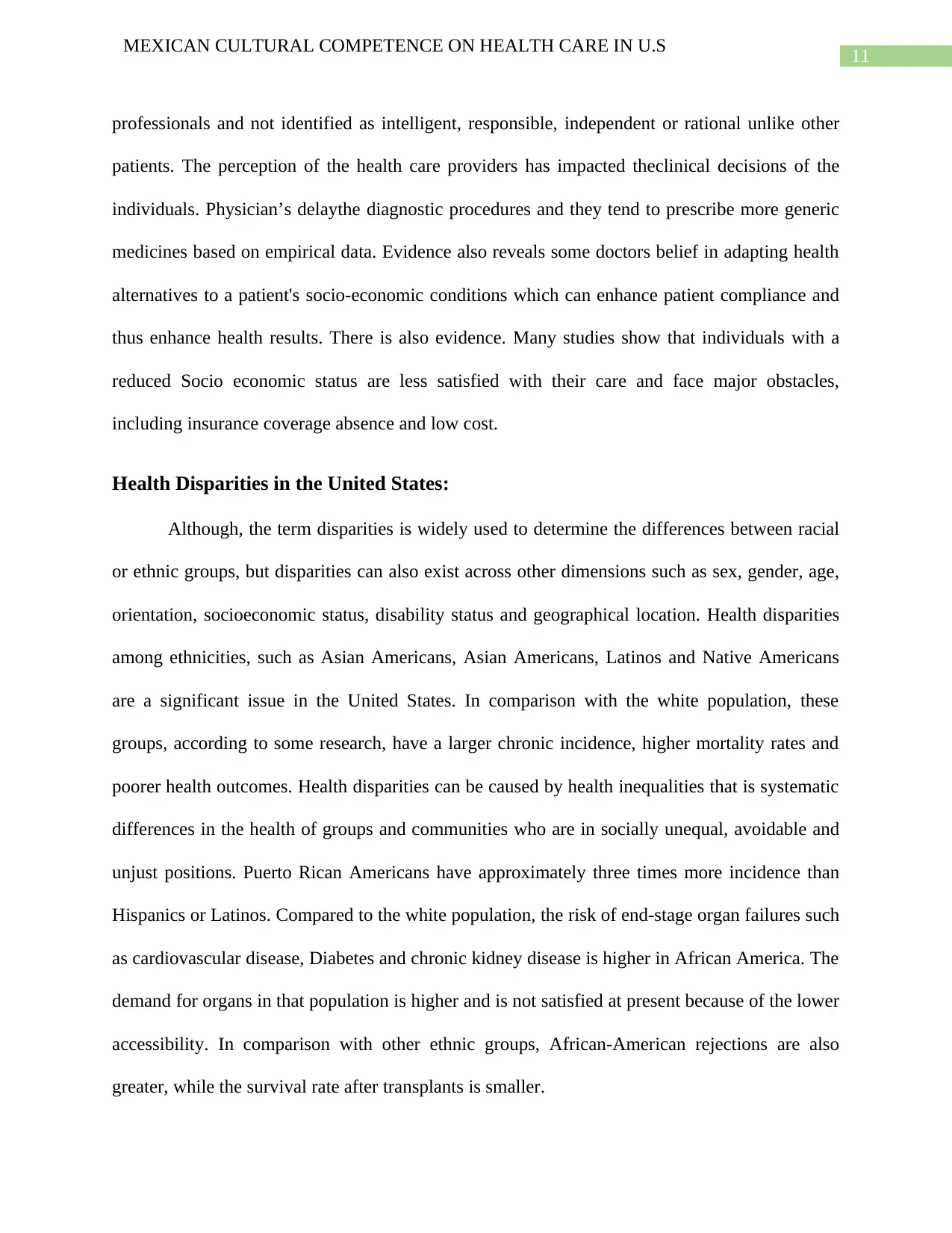
11
MEXICAN CULTURAL COMPETENCE ON HEALTH CARE IN U.S
professionals and not identified as intelligent, responsible, independent or rational unlike other
patients. The perception of the health care providers has impacted theclinical decisions of the
individuals. Physician’s delaythe diagnostic procedures and they tend to prescribe more generic
medicines based on empirical data. Evidence also reveals some doctors belief in adapting health
alternatives to a patient's socio-economic conditions which can enhance patient compliance and
thus enhance health results. There is also evidence. Many studies show that individuals with a
reduced Socio economic status are less satisfied with their care and face major obstacles,
including insurance coverage absence and low cost.
Health Disparities in the United States:
Although, the term disparities is widely used to determine the differences between racial
or ethnic groups, but disparities can also exist across other dimensions such as sex, gender, age,
orientation, socioeconomic status, disability status and geographical location. Health disparities
among ethnicities, such as Asian Americans, Asian Americans, Latinos and Native Americans
are a significant issue in the United States. In comparison with the white population, these
groups, according to some research, have a larger chronic incidence, higher mortality rates and
poorer health outcomes. Health disparities can be caused by health inequalities that is systematic
differences in the health of groups and communities who are in socially unequal, avoidable and
unjust positions. Puerto Rican Americans have approximately three times more incidence than
Hispanics or Latinos. Compared to the white population, the risk of end-stage organ failures such
as cardiovascular disease, Diabetes and chronic kidney disease is higher in African America. The
demand for organs in that population is higher and is not satisfied at present because of the lower
accessibility. In comparison with other ethnic groups, African-American rejections are also
greater, while the survival rate after transplants is smaller.
MEXICAN CULTURAL COMPETENCE ON HEALTH CARE IN U.S
professionals and not identified as intelligent, responsible, independent or rational unlike other
patients. The perception of the health care providers has impacted theclinical decisions of the
individuals. Physician’s delaythe diagnostic procedures and they tend to prescribe more generic
medicines based on empirical data. Evidence also reveals some doctors belief in adapting health
alternatives to a patient's socio-economic conditions which can enhance patient compliance and
thus enhance health results. There is also evidence. Many studies show that individuals with a
reduced Socio economic status are less satisfied with their care and face major obstacles,
including insurance coverage absence and low cost.
Health Disparities in the United States:
Although, the term disparities is widely used to determine the differences between racial
or ethnic groups, but disparities can also exist across other dimensions such as sex, gender, age,
orientation, socioeconomic status, disability status and geographical location. Health disparities
among ethnicities, such as Asian Americans, Asian Americans, Latinos and Native Americans
are a significant issue in the United States. In comparison with the white population, these
groups, according to some research, have a larger chronic incidence, higher mortality rates and
poorer health outcomes. Health disparities can be caused by health inequalities that is systematic
differences in the health of groups and communities who are in socially unequal, avoidable and
unjust positions. Puerto Rican Americans have approximately three times more incidence than
Hispanics or Latinos. Compared to the white population, the risk of end-stage organ failures such
as cardiovascular disease, Diabetes and chronic kidney disease is higher in African America. The
demand for organs in that population is higher and is not satisfied at present because of the lower
accessibility. In comparison with other ethnic groups, African-American rejections are also
greater, while the survival rate after transplants is smaller.
⊘ This is a preview!⊘
Do you want full access?
Subscribe today to unlock all pages.

Trusted by 1+ million students worldwide
1 out of 17
Related Documents
Your All-in-One AI-Powered Toolkit for Academic Success.
+13062052269
info@desklib.com
Available 24*7 on WhatsApp / Email
![[object Object]](/_next/static/media/star-bottom.7253800d.svg)
Unlock your academic potential
Copyright © 2020–2025 A2Z Services. All Rights Reserved. Developed and managed by ZUCOL.





